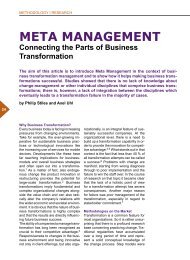Digital Enterprise Transformation - 360° Journal
Digital Enterprise Transformation - 360° Journal
Digital Enterprise Transformation - 360° Journal
- No tags were found...
Create successful ePaper yourself
Turn your PDF publications into a flip-book with our unique Google optimized e-Paper software.
DRIVERS14Key Learnings►►►►►►►►Near Field Communication (NFC) is becoming ubiquitouswith NFC devices becoming mainstream.Customers view NFC as safe and convenient and arewilling to swipe and pay.Players in the retail value chain need to look beyond NFCas a payment method and identify how NFC enablesricher interactions with customers.Changes in the retail payment value chain will enablefinancial service providers to offer small and medium sizecustomers a range of applications as hosted solutions togrow revenue and retain customers.Mobile network operators will initiallytry to position themselves in the mobileand contactless payment market, for example,as already mentioned, the ISIScollaboration in the USA and mpass inGermany. However, it is unclear whetheroperators can carve out a new, profitableniche beyond mere data transmission.NFC payment via mobile devices willintroduce a number of new technologycompanies into the traditional retail valuechain. These will include device manufacturers,operating systems and applicationsvendors (e.g. Google with Androidand GoogleWallet) as well as technologycompanies that offer a complete mobiletechnology solution (e.g. Apple withiPhone/iPad as device, iOS as operatingsystem and iTunes as software and paymentplatform). From a traditional financialservice provider’s perspective, suchas Visa or MasterCard, these companiesoffer potential for partnerships to provideapplications to merchants, or embedtheir payment and clearing systems intothe offerings of software providers.6) TechnologyOn the one hand, NFC and adequatedata transition technologies are the keyto enabling card issuers to transformtheir position in the retail value chain. Onthe other hand, other technologies, suchas the QR code (Quick Response code)could substitute NFC in a limited way.Furthermore, evolving mobile phonestandards and mobile internet connectionsare available, but these will havelittle material impact when comparedwith the increasing adoption of NFC.7) RiskPreviously, the major risk regarding theability of NFC to transform the role of cardissuers in the retail value chain has beenseen in the user acceptance. The successof micro payment via NFC systemsand the findings of the above mentionedcurrent research counter this position.However, we should not underestimatean additional risk: the threat that mobileoperators, who are actively promotingmobile applications to business customers,could compete for retailer’s spend inthe location-based CRM market as well.GPS positioning could locate a high-rollerin a store without the need for swipinga card. However, the intrusive BigBrother connotations of the GPS basedscenario should not be underestimatedand will provide a competitive barrierwhen compared with the more “opt in”NFC approach, in which customers actively“swipe in” to provide their locationto retailers.Having considered the impact of NFCadoption we can conclude that the technologyhas the ability to dramatically enhancethe role played by financial serviceproviders within the retail value chain.However, these companies will only realizethe benefit of this shift if they committo develop their value proposition tocustomers. Those who supplement theircommodity payment and clearing serviceswith new NFC related customer managementofferings will retain customersand gain market share, whilst companiesthat do not embrace this opportunity fortransformation will miss out on new revenuestreams.













